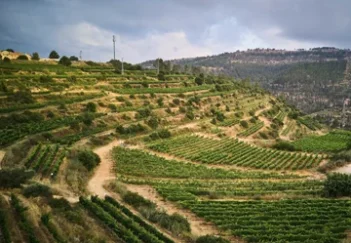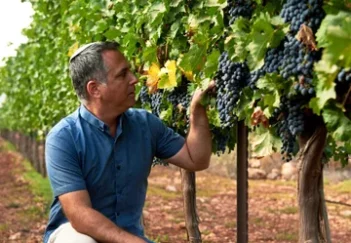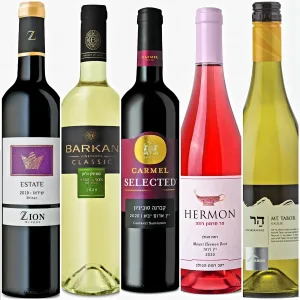Mid 1800’s
Wine in modern times in Israel did not begin with the Golan Heights Winery in the 1980’s. Or even with Carmel Winery in the 1880’s. It began in the Old City of Jerusalem in the mid 19th century, with a Karliner Hassid called Rabbi Mordechai Avraham Galin, who made aliyah from White Russia in 1835 and settled in Safed. When he was made Rosh Yeshiva of Tiferet Israel, he moved to Jerusalem. In those days the Jewish community was very poor. For this reason, his son, Rabbi Yitzhak Galin decided to open a winery, in order to gain an income.
He married the daughter of Aaron Shor, the owner of a wine store and decided to adopt her surname in order make use of the permit they had from the Turkish authorities, allowing him to open a winery. Shor Winery was opened in the Jewish year 5608, which corresponds to 1847-48 and the first harvest coincided with Sir Moses Montefiore’s third visit to Israel.
Moses Montefiore was a wine lover and connoisseur, drinking a bottle of wine every day. He believed that Jews should work for a living, not just live off charity and recommended agriculture as a trade. He outlined his agricultural vision in 1839. Daniel Rogov, the late esteemed wine writer wrote: “The inspiration of Rabbi Shor was Sir Moses Montefiore, who visited the Holy Land on numerous occasions, and while here encouraged the Jews to work the land and plant vines.”
The winery was situated in a cellar in Haggai Street alley backing on the Western Wall. Family members relate that a row of wine barrels were placed along the part of the Holy Wall adjoining the winery, so that forgetful workers would not touch it by mistake!
Efrat was another company operating in the Old City. The Teperberg family came to Israel from Odessa, via Austria. Since 1852 they were retailers and distributors of wines & spirits, specializing in the Christian market. In 1870 Zeev Zeida Teperberg founded Efrat Winery. This winery continues today under the family name Teperberg and it is the largest family owned winery in Israel.
The wineries used to receive grapes delivered on donkeys from Hebron. This may have included local white varieties like Hallili (aka Hevroni), Sallati, Marawi, Sharwishi, Dabuki, Jandali, Halbani, Romi, Hadari and Hamdani. Or red varieties like: Zeitani, Singeli, Karkashani, Razaki, Shemi, Karashi and more.
Most of the wine was sweet, simply because a sweet wine was more likely to last. The main market was for the Jewish community wishing to make Kiddush. There was also a Christian market seeking Altar or Communion wine from ‘the Holy Land.’
In 1870 the Mikveh-Israel Agricultural School was founded, southeast of Jaffa. The school, under French patronage and managed by Charles Netter from Alsace, emphasized the new importance of agriculture. They were the first to use European varieties, like Carignan from the south of France. Many of the new wave of immigrants who “returned to Zion” towards the end of the nineteenth century, learned the rudiments of agriculture at the school, before planting vineyards elsewhere.
Late 1800’s
In 1882 Jews from Russia and Romania set up the new villages of Rishon Le Zion & Zichron Ya’acov. They sought financial assistance from Baron Edmond de Rothschild. He was a banker and art collector, who lived in Paris, and he was also owner of Chateau Lafite in Bordeaux, one of the most famous wineries in the world. He not only offered support but commisioned a report to survey the agricultural possibilities in what was a barren land. One of his expert horticulturists, summoned from the Palace of Versailles to visit Palestine, recommended vineyards as being the solution in 1882. The first experimental vineyards were duly planted.
Initially efforts were made to plant wheat and potatoes, but these did not succeed. However the vineyards thrived. So the farming villages formally decided to turn to grapes in 1884. They planted varieties like Alicante (Grenache), Carignan, Espart (Mourvedre), Bordolo (Cinsault), Brachet and Petit Bouschet.
In 1887 Baron Rothschild visited for the first time and fell in love with the Mount Carmel area, which he thought was Israel’s Tuscany or Provence. He then decided to create a wine industry. Rothschild brought in the best agronomists from France, winemaking expertise from Bordeaux and the finest equipment money could buy to ensure his project was a success.
He was determined to make a great Bordeaux style wine. So he sent cuttings of Cabernet Sauvignon, Cabernet Franc and Malbec, taken from Lafite’s vineyard. When the scourge of phylloxera hit the vineyards in the 1890’s, they circumvented the problem by bringing cuttings from a nursery in Kashmir. These became known as ‘the Indian vines’.
Even though Rothschild’s view was visionary, his dream for a quality Bordeaux style wine was not realized in his lifetime. The growers did not like the low yields of these varieties and there was no real market for a fine Palestine wine. When the diseased Bordeaux varieties had to be ripped out, they were replanted with varieties like Carignan, Alicante, Clairette & Ugni Blanc.
In the meantime, Rothschild built Israel’s first commercial wineries at Rishon Le Zion in 1890 and at Zichron Ya’acov in 1892, and sent a Bordeaux winemaker to take charge. Charles Mortier, winemaker of Chateau Lafite, was a consultant. The wineries were very large by world standards and extremely advanced for their time. The first time electricity and the telephone were used in Israel was at the Rishon & Zichron wineries.
Rothschild then built deep underground cellars at Rishon le Zion & Zichron Ya’acov in order to keep the wine at a steady temperature. The project was begun in 1893 and finished in 1896. The deep underground cellars, which were 50 meters long, were more successful in maintaining a steady temperature. The cellars at Rishon Le Zion cost the Baron 6 million francs and at Zichron Ya’acov the cost was 5 million francs. (By comparison, the purchase of Chateau Lafite only cost the Rothschild family 4 million francs!)
In 1895 the Carmel Wine Co. was formed by E.Z. Lewin-Epstein, one of the founders of Rehovot, to market the wines of Rishon and Zichron overseas. The first export office was opened in Warsaw in 1896, followed by Austria (1897), Germany, Britain (1898) and America (1900). The company in Britain was known as “Palestine Wine Co.”, hence the brand ‘Palwin.’ Carmel became Israel’s first exporter and first brand.
There were also some wineries run by monasteries. The Latroun Monastery, founded in 1890 by Trappist Monks from France, produced wines under the name Domaine de Latroun, sourced from their own vineyards. It is situated just off the Tel Aviv – Jerusalem Highway. They used French varieties like Gewurztraminer and Pinot Noir before other Israeli wineries.
Cremisan Winery was founded by Cremisan Monastery at Beit Jalla, situated not far from Bethlehem. It was founded by Salesian Monks from Italy in 1895. They managed to keep alive some of the original local varieties alive such as Jandali, Hamdani and Dabuki amongst the whites and Baladi, amongst the reds.
The Templars from Germany also greatly contributed their agricultural skills to the Holy Land’s development. They were advanced agriculturally and in 1893 they opened their winery in the Sarona district of Tel Aviv, in between the Kyria and Montefiore Quarter. They were the first to bring German varieties to Israel, such as Sylvaner. However they returned to Germany at the onset of World War II.
Early to Mid 1900’s
In 1902 the name Carmel Oriental was first used to denote the company marketing wines to places like Beirut, Damascus, Constantinople, Alexandria as well as Jaffa & Jerusalem. Carmel even had a branch in Cairo. When Hebrew became the accepted language, the company name was translated to Carmel Mizrahi.
The first major award to be given to an Israeli wine was the Gold Medal presented to Carmel No.1 at the famous Paris Exhibition of 1900. Carmel shared the winner’s podium with some of Bordeaux most famous Chateaux!
In 1906 the management of the wineries at Rishon le Zion and Zichron Ya’acov was deeded to the growers, who founded the “Société Cooperative Vigeronne des Grandes Caves, Richon-le-Zion and Zichron Jacob Ltd.”. The registration of the name in French was in recognition of the Baron’s contribution. The cooperative included vineyards in all the new farming villages funded by Rothschild, both Rishon Le Zion and Zichron Ya’acov Wine Cellars, and two marketing companies. Carmel Oriental took care of the ‘domestic market’ of the Ottoman Empire and Carmel Wine Co. was for export markets. The cooperative was to stay in operation for 107 years.
Two future Israeli prime ministers worked in the wine trade in the early years. Israel’s first prime minister, David Ben-Gurion, worked at Rishon le Zion Cellars in 1907. Levi Eshkol, Israel’s third prime minister, managed the original vineyards, then surrounding the cellars at Rishon in 1915.
The wine business expanded and sales increased particularly during the First World War, when German, British and Australian troops passed through the country. When the war was over though, the industry lost its principal markets: Russia, because of the Revolution; the United States because of Prohibition and Egypt and the Middle East because of Arab nationalism. Many vineyards were replaced with citrus groves, almonds and olive trees.
In 1925 the British decreed that businesses had to move out of the Old City. This and the Arab riots of 1929, encouraged Shor Brothers to move to a new home in Beit Israel, near Meah Shearim. Efrat moved to .
In 1934, Baron Edmond de Rothschild passed away. He remains were later reinterred in the beautiful Ramat Hanadiv Gardens, on the southern slopes of Mount Carmel, overlooking the sea and the winery & vineyards he loved so much.
During this pre-state period, Carmel was the dominant winery. Rishon Le Zion and Zichron Ya’acov were, by far, the two largest wineries in Israel. Carignan and Alicante were the main planted varieties. Most vineyards were concentrated in the valleys surrounding Zichron Ya’acov & the central coastal plain around Rishon Le Zion and Rehovot.
Adam Montefiore. He works for Carmel Winery and regularly writes about wine in both Israeli and international publications.

















